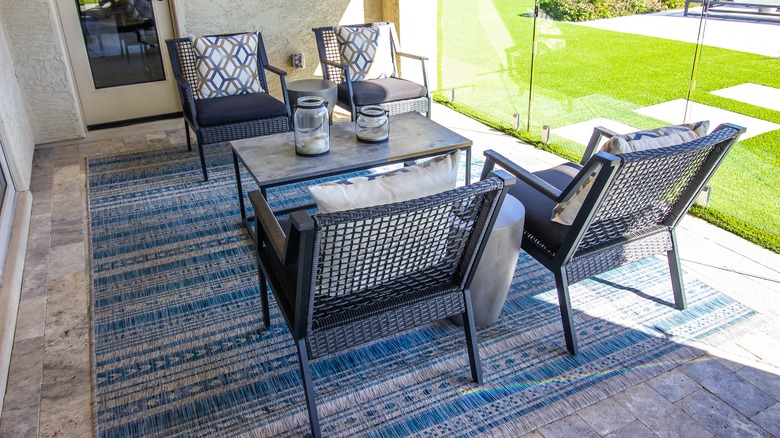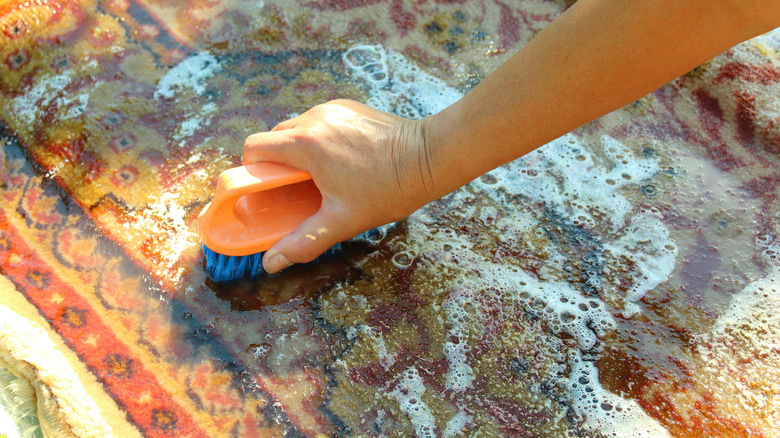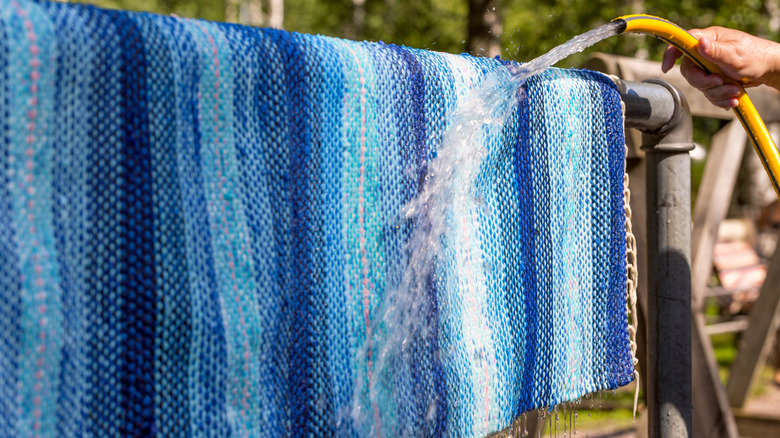You're Probably Cleaning Your Outdoor Rug All Wrong
While an outdoor rug can add a stylish accent to your back patio, the colors may start to look muted over time. After withstanding the elements, a lot of foot traffic, and maybe more than one spill during a backyard barbeque, your once-vibrant patio rug could benefit from a good cleaning. Don't make the mistake of assuming you need to rent expensive equipment or buy specialty cleaners to get the job done. It's also misleading to think that an occasional spot cleaning or a quick touchup with a handheld vacuum is going to remove the mold or mildew that has built up. Most of the time, you can make a big difference in the appearance of your rug simply by using a little dish soap and a garden hose.
It's a good idea to give your rug a thorough cleaning every couple of years in order to prolong its life and protect the investment you made when purchasing it. Most rugs are made from either synthetic materials, such as nylon or polypropylene, or from natural materials, such as sisal or seagrass. You can begin by researching the cleaning instructions for your particular type of carpet, which can often be found online if there isn't a tag attached. However, it's usually unnecessary to spend a lot of money to clean most kinds of rugs. A diluted dish soap solution is gentle enough to use for most materials, and it can make your outdoor rug look vibrant and stylish again.
Use a dish soap solution
The first step in giving your carpet a thorough cleaning is to remove all of the excess debris and dirt. Use a broom that has soft bristles to sweep off the surface, then shake loose the additional material that's buried in the fibers. If the rug is a modest size, pick it up by the corners to shake it out. If it's too large to shake out by hand, then drape it over a fence or a railing, and strike it with a broom handle. Turn the rug over and continue to knock the dirt loose on the other side as well. Then place it on the ground to vacuum it thoroughly, and complete this step on the reverse side as well.
At this point, your rug should already be showing signs of improvement, but giving it a good shampooing is the best way to remove the rest of the grit that is buried inside. Mix together a tablespoon of clear dish detergent in a bucket filled with a gallon of warm water. Test this soap mixture on a corner of the underside of the carpet to ensure that it is safe for the fabric. If the colors don't fade, then you're ready to apply this soapy mixture to the entire surface of the rug. Work it into the fibers gently with a soft brush, then turn the carpet over and apply the shampoo to the other side as well.
Apply spot treatment
After you've let the soap soak into the rug for a few minutes, prepare to rinse it by laying it on a surface where it can drain. Either drape it over a railing or fence, or place it on a sloped driveway. Don't make the mistake of leaving the carpet on a flat surface surrounded by dirty water, as this can lead to the development of mold. Hose down one side of the carpet until the water runs clear, then flip it over and rinse the other side as well. In order to drain the excess water from the surface, roll the carpet up and stand it on its side for a few minutes. Then lay it out in the sun where it can continue to drain and start to dry. Don't forget to flip it over again to let the sunshine reach the other side.
As you lay the rug out to dry, check for any areas that may need spot treatment. For stubborn mold or mildew, pour diluted vinegar on the area for a few minutes, then rinse thoroughly and allow the carpet to dry in the sun. For a difficult stain such as red wine, combine baking soda with a little water and apply it to the spot. Let it dry and then vacuum it up. Giving your rug a thorough cleaning every so often will give it a new life and enhance the time you spend on your patio for many more seasons.


